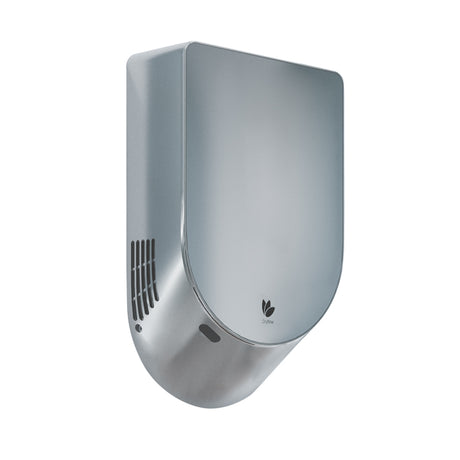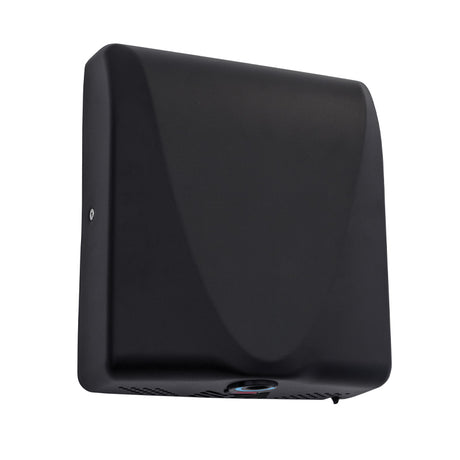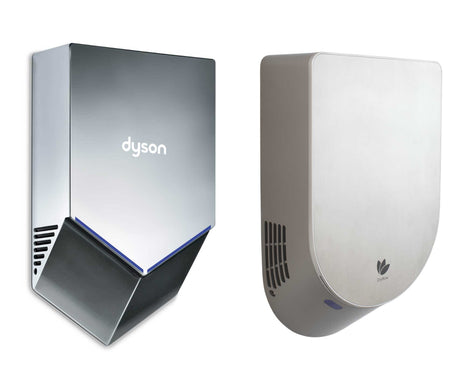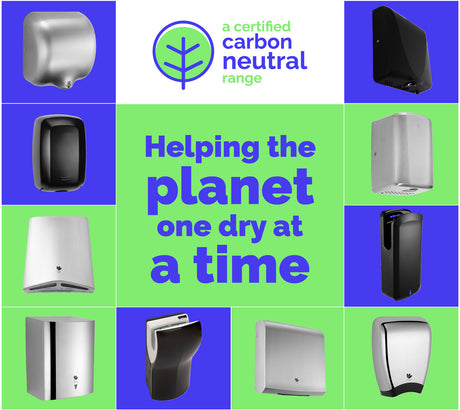A quick google search and you can find it quoted that damp hands are 1,000 times more likely to pick up bacteria than dry hands! This includes the work of Patrick et al. (1997) who state that drying the hands using a towel or hand dryer :
“reduced the bacterial numbers translocating to skin, food and utilities on touch contact….. and achieved a 99.8, 94 and 99% reduction in the level of bacterial transferring from one surface to another associated with wet hands.”
Has COVID-19 meant that non-touch appliances in the washroom are the future now? We looked into this question, and the findings are quite interesting!

The 4 ways to dry your hands include:
- Rubbing the hands together under a hand dryer
- Forwards and backwards, hands apart in or under a hand dryer
- The Jidō Kansō movement in or under a hand dryer
- Manual rubbing the hands with a paper or cloth towel.
Considering the findings by EMLab P&K, highlighted by CBT Nuggets that there are:
- 4,620,000 bacteria units per square inch on an ID badge
- 3,543,000 bacteria units per square inch on an office keyboard
- 1,600,082 bacteria units per square inch on a mobile phone
Leaving the washroom with wet hands and touching stuff allows ideal transport for bacteria to get on your hands. Then you touch your face, eyes, nose or mouth and put them in your body or pass on the bacteria when you touch another surface, or indeed when you make physical contact such as shaking hands.
At the time of writing, during a global pandemic of Coronavirus, the World Health Organisation and the Centres for Disease Control and Prevention recommend the following regarding hand drying
The World Health Organisation :
“To protect yourself against the new coronavirus, you should frequently clean your hands with an alcohol-based hand rub or wash them with soap and water. Once your hands are cleaned, you should dry them thoroughly by using paper towels or a warm air dryer.”
The Centres for Disease Control and Prevention (CDC) :
“…the best way to dry hands remains unclear because few studies about hand drying exist, and the results of these studies conflict. Additionally, most of these studies compare overall concentrations of microbes, not just disease-causing germs, on hands following different hand-drying methods. It has not been shown that removing microbes from hands is linked to better health. Nonetheless, studies suggest that using a clean towel or air drying hands are best”There’s a standard set for washing the hands, but as yet no set way to dry the hands. This is mainly due to the variation in air outlets (blade style, rounded, multi-jet), styles (hands under or hands in) or type such as paper / cloth towel, therefore a standard method is difficult to prescribe.
There are some recommendations however which can be used across different types of drying methods. This post highlights some of the techniques available to try.
General considerations
Whatever method is in front of you, you need to make sure the whole of the hand, including between the fingers and under the nails, is dry.
Using a hand dryer, it’s easy to get underneath the nails and between the fingers. Firstly, this happens naturally as the air encompasses the hands, whilst it’s also good practice to open up the fingers and angle the hands to ensure this happens better. You can of course still achieve this with a paper towel but it is much more dependent on the user whether they decide to dry these areas or not.
Key point: Take the time required to dry every part of the hands not forgetting potential breeding grounds like between the fingers and under the nails.
“Hands under” hand dryers
When confronted with a “hands under” dryer, there’s usually only one direction of air outlet. So, alternately rotating the hands making sure both the palms and the backs of the hands meet the airflow is a must for complete drying.
Traditionally when using a “hands under” dryer it’s a natural occurrence to rub the hands together to help the removal of water. All our dry speed tests use this method to compare hand dryers, as this is how they would most commonly be used.
There are 2 studies which have found that rubbing the hands together when drying can naturally bring your normal, non-harmful bacteria to the surface of the skin Yamamoto et al. (2005); Snelling et al. (2011) . In the study by Snelling et al. (2011) it was suggested that rubbing the hands together disturbs the outer skin and brings bacteria from within the pores to the surface.
Don’t forget not all bacteria are bad bacteria, some we need to keep in the body as it does it good. MedlinePlus is a service of the National Library of Medicine (NLM), the world’s largest medical library, which is part of the National Institutes of Health (NIH). They state “Most bacteria won’t hurt you – less than 1 percent of the different types make people sick. Many are helpful. Some bacteria help to digest food, destroy disease-causing cells, and give the body needed vitamins. Bacteria are also used in making healthy foods like yogurt and cheese.”
So, is it better to dry the hands without rubbing them together? Mitsubishi and Dyson seem to think so, however their units have blade style air outlets, which could be the reason why.
Dysons HU02 and HU03 models are both “hands under” types with their Airblade technology. To use them they state:
- Keep your hands flat and parallel to the machine’s surface, approximately 5mm from the blade / air aperture, drawing your hands through the airflow from your wrists to finger tips.
- Move your hands slowly through the airflow, keeping a consistent speed (approx. 2.5 seconds per side), alternating between front and back each time.
-
Keep your hands flat, close the gaps between your fingers and keep your thumbs tucked in, so the whole of your hand is drawn through the airflow.
Mitsubishi say that their Jidō Kansō movement used with their
Jet Towel Smart
allows for water to be scraped away from the user, not onto them, and onto the wall where it can be cleaned as opposed to straight down to the floor, leaving a pool of water.
The Jidō Kansō is a circular movement of the hands which can be used vertically or horizontally.
It consists of inserting the hands from the sides of the drying area with the hands drawn through the air so that water on the hands is stripped off away from the user in a controlled manner.
We’ve shown using this method, with the Smart, it creates a faster dry than moving the hands backwards and forwards or the traditional rubbing the hands together. By performing this action, water is traveling in one direction, stopping water being blown back onto the hands with a backwards / forwards motion. See below video for more information.
“Hands In” hand dryer
These have the benefit of getting rid of moisture from both sides of the hands without having to turn them or having to rub the paper towel over every part of the hand to make sure all moisture is collected.
The Dyson Airblade AB14
recommends that you “Move your hands up and down slowly through the air.”
This technique has been questioned by Mitsubishi and again they recommend the Jidō Kansō movement be used with their
Jet Towel Slim
. Mitsubishi state the advantage of using this technique in a “hands in” style unit is the water is scraped straight down, rather than potentially up and out of the dryer
if the hands are inserted into the airflow from above
.
I guess they have point. If you’re scraping the water towards you, there’s more chance of it exiting the hand dryer and onto the user or surrounding area.
Paper towels or cloth towels
There’s no real guidance on technique here, however as discussed in the theme of this post, the key is to make sure every part of the hand is dry, including under the nails and between the fingers. A process that is reliant much more on the user than when a hand dryer is used. They dry fast, but the effectiveness is user specific.
Joe Smith in the video below gives examples of how to only use 1 paper towel at a time to get a thorough dry:
Considerations for hand dryers or paper towels
The obvious thing is to make sure you have first thoroughly washed your hands . This is the most vital point of hand hygiene where germs and viruses are killed and washed away. A hand dryer or paper towel is there to dry the hands as a further protection to picking up germs, not to remove dirt and bacteria.
For added protection, hand dryers are now very rarely seen with a manual activation button but touch free sensor operation. Paper towel dispensers are also touch free in theory and there are automatic choices available . Some hand dryers and paper towel dispensers come with antimicrobial additives in their materials to kill any bacteria left on surfaces from splash back.
Here’s something to bear in mind though. If paper towels are only available in a manual dispenser; be careful you don’t place your fingers in the dispenser opening.
According to this scientific paper – Bacterial Transfer and Cross-Contamination Potential Associated with Paper-Towel Dispensing – printed in the American Journal of Infection Control, wet hands reaching into dispensers to unblock them leaves a wet, damp environment for the next user. An environment ideal for bacteria to grow in. The authors state “Paper-towel exits from folded paper towel dispensers located at handwash stations in food processing facilities have been found contaminated with Eshcerichia coli. More recently, studies have indicated towel dispenser exits in hospitals are often not included in routine cleaning and are contaminated”
The zig zag of hands to paper-towel dispensers and back again, especially when people often have trouble taking paper towels from the dispenser, allows any residual germs from poor washing to transfer to the dispenser outlet and next lot of paper towels through contact. Also leaving a moist environment ideal for growing any transferred bacteria at the dispenser exit.
You may want to make sure you are not using the same part of paper towel for each section of hand or make sure you use more towels to do the job. The latter is obviously not the most sustainable, environmentally friendly option though. Paper towels have been shown in studies to be very good at removing bacteria from the hands, however a study has shown that bacteria can transfer back to the hands from a previously unused paper towel so why not one that has just been used?
Finally making sure rubbish bins of paper towels are emptied is crucial, as well as cleaning down walls and floors where residual water from the hand dryer may be blown, although the latter are usually no touch zones. We know that moist areas are an ideal area from bacteria to grow and Taylor et al. (2000) state “paper towels would be deposited in bins and therefore, could potentially act as a bacteriological reservoir if disposal was not managed correctly.” In other words, a bacteria breeding ground in the washroom.
Key Point
Hand drying techniques vary because of the variation in modes and methods available. The trick is to test what works best for you when faced with the different drying product in front of you. All methods available from paper towel to hand dryer will be effective if used correctly.
The main message though from all of this is:
Whatever technique or method you use, take the time to make sure every part of your hand is fully dry before touching anything else. That includes in between the fingers and under the nails!




